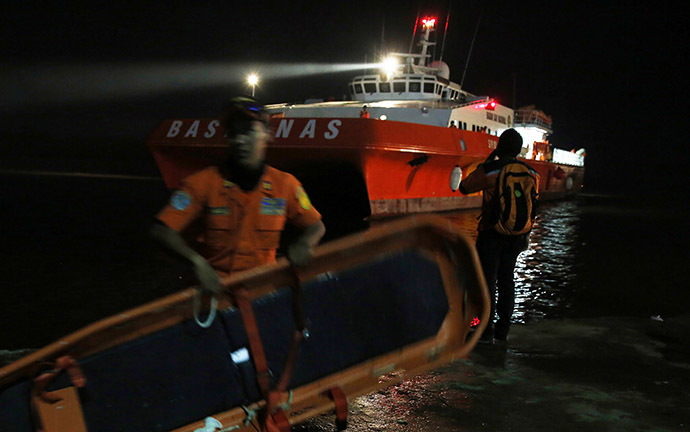Frozen instruments, deliberate crash? AirAsia plane crash versions multiply

The discovery of the AirAsia airliner’s fuselage in the Java Sea raises new questions about what caused the crash. Possible versions range from misread instruments leading to a stall to a murder-suicide.
AirAsia flight QZ8501 abruptly went off radar on Sunday over the Java Sea shortly after the pilot requested air control in Jakarta for permission to climb higher to avoid a storm. The permission was granted two minutes later, but no response from the crew followed.
The plane disappeared from radar screens three minutes later. No distress call was sent by the plane. Both facts indicated that it fell very quickly, with initial speculation saying that it could have suffered catastrophic destruction in mid-air. But the discovery of the plane’s body lying in one piece on the seabed proved otherwise.
READ MORE: AirAsia tragedy: Fuselage detected by sonar
Recovering data from flight and cockpit recorders would be crucial for establishing the truth about the fate of QZ8501, but some flight experts point out that the AirAsia Airbus A320 crash has similarities with another flight incident, that of Air France flight AF447 in 2009.
The plane was officially classed as missing for two years and was found only in 2011. The investigation showed instruments called pitot tubes froze and gave false airspeed readings to the crew. They failed to respond to the problem accordingly and didn’t notice that the plane was about to stall or to try to recover it.

"No two accidents are the same. But there are similar conditions like the weather, and we must look into it very closely," a former air crash investigator in Indonesia told Reuters.
Unlike the AirAsia flight crash, Air France airliner stalled at nighttime when the crew couldn’t see the horizon line and see that the aircraft was losing altitude.
QZ8501 was piloted by an experienced 53-year-old ex-Indonesian Air Force pilot known by the single name Iriyanto, who had 20,000 flying hours under his belt, including 6,100 hours in Airbuses. The co-pilot was Frenchman Remi Plesel with 2,275 flying hours.
AirAsia CEO Tony Fernandes expressed confidence in his pilot, saying he was one of the best graduates at his military flight school. The Airbus A320 is a reliable aircraft with just 0.14 fatal accidents per million takeoffs, according to a safety study published by Boeing in August. With neither human error nor technical failure immediately pinned down as a likely cause, more sinister theories about the crash have arisen.
The plane could have been damaged by a small bomb exploding onboard, John Nance, a former US Air Force pilot, told ABC News.
"Maybe one that wasn't strong enough to blow the airplane into pieces at altitude, but maybe one that blew the control cables from the hydraulics," he said.
An even more exotic version would be a deliberate crash by the pilot in a murder-suicide, Nance added. At least three crashes in the past 20 years were caused by this.
One example is SilkAir Flight 185, also from Indonesia, which crashed into a river in southern Sumatra in 1997. Indonesian investigators reported that they couldn’t collect conclusive evidence to rule on the cause of the incident.
But the US National Transportation Safety Board, which participated in the investigation because the aircraft in question was a Boeing 737, said the plane crashed due to deliberate input from the cockpit, most likely by the captain.

New data indicates excessively steep climb before crash
New data from the radar which has been analyzed by investigators
researching the cause of the AirAsia Flight has apparently shown
that the plane attempted an “unbelievably” steep attempt at an
incline – one that was perhaps too much for the jet to cope with.
“So far, the numbers taken by the radar are unbelievably
high. This rate of climb is very high, too high. It appears to be
beyond the performance envelope of the aircraft,” a source
familiar with the probe's initial findings told Reuters.
The person told the agency that despite the preliminary
assessment, the data upon which the analyses had been made was as
of yet incomplete.
“With the CVR (cockpit voice recorder) and FDR (flight data
recorder), we can establish what went on in the cockpit and what
was going on with the aircraft. We can conclude if the radar
information is accurate,” the source stated.
Previously, a picture had leaked from AirNav Indonesia seemingly
depicting the plane climbing at 353 knots while already at an
altitude of 36,300 feet.

The agency had two veteran pilots assess the situation, with both
concluding that the aircraft may have climbed very suddenly and
then dropped in speed – which could have resulted in a sudden
stall.
“If you encounter turbulence, you go slower at what we call
the turbulence penetration speed to get through it. If you climb
to avoid turbulence, you slow down to have a better climb rate.
That could be around Mach 0.76,” he said. “But if you
climb suddenly and start to lose speed, you will stall,” one
of the pilots told Reuters.
The source did however express a desire to investigate why other
planes in the area were not similarly affected by the severe
weather conditions while not appearing to “to encounter any
major problems”.
While the Airbus A320 usually manages to stop its pilots from
transcending predetermined safe flight parameters, they can under
some circumstances be overriden by the pilot and manual flying
skills.













